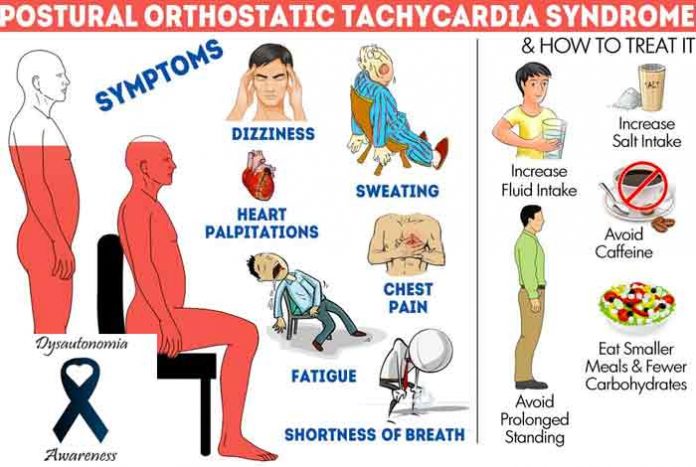
POTS or postural orthostatic tachycardia syndrome is a malfunction of the autonomic nervous system that controls the involuntary functions of the body such as heart beat, digestion, breathing, blood pressure, blinking and urination. The disease is not known to affect any part of that system and the most commonly observed symptoms include profound fatigue, frequent and constant lightheadedness, and gastrointestinal issues. This disease is being made popular by the Dysautonomia International that is involved in POTS education, research, and patient empowerment.
The Medical Director of the autonomic investigation unit at the Libin Cardiovascular Institute of Alberta, Dr. Satish Raj states that the patients with POTS do not do we with gravity. When a normal person stands up, his heart rate automatically increases by about 10 to 15 beats per minute in order to escalate the blood pressure and blood flow and then it becomes stable. However, in people with POTS, this increase in heart beat is at least by 30 beats a minute within a time span of 10 minutes and in some cases can be as high as 60 beats per minute. This causes the brain to interfere in this process of increasing heart beat and the patient faints.
Research showed that the patients with POTS lead a similar life like that of congestive heart failure, or chronic obstructive pulmonary disease.
It is believed that POTS affects nearly 1 and 3 million Americans. However, due to lack of awareness about the disease in the medical community, experts believe these numbers could be much higher, both in the US and in the rest of the world. It is estimated that 1 in 100 teens develop POTS.
POTS and Depression
Nearly 80% of POTS patients are women and nearly half of them are young and relatively healthy before the condition strikes. This makes it difficult for them to find a doctor who is willing to take their symptoms seriously. They often tell the patients that they might be having depression or anxiety.
As per a survey done by Vanderbilt and the University of Calgary on POTS, which accounts to be the largest one till date, it was found that most of the people consulted on an average of 7 different doctors in the span of nearly 4 years before being correctly diagnosed with POTS. These statistics might sound bad but they are much improved than what they used to be 10 years ago. As per the survey, it was revealed that out of 4,178 diagnosed POTS patients, more than 75% were told that their symptoms were of psychological nature; 25% of these people said that they were treated for a mental disorder before they were correctly diagnosed with POTS. Similar results were observed when a study[2] was done on 779 patients from UK said that nearly 48% of them got diagnosed with psychiatric disorder or were thought to be hypochondriacs before getting accurate diagnosis.
Tough Diagnosis
It is observed that POTS patients can often clearly trace back the event when their symptoms [3] started developing like a major surgery, viral illness or trauma. Doctors often tell the patients that this is in their head or its purely neurological or neurological cancer and several other diseases before coming to POTS.
Role Played by Dysautonomia International
Dysautonomia International was started in 2012 and had every autonomic expert she could find that was familiar with POTS and other forms of dysautonomia on its advisory board at the time of its inception. It offers several support groups, information to find a doctor, tips on coping with the disease and education for employers, physicians, family and friends. Gradually, major research organizations also started collaborating with Dysautonomia International and began their research on this disorder. These research organizations were more than excited to get hundreds of people diagnosed with POTS in one location. They started collecting family history, medical test results, and blood serum samples from the patients. Since very little information is available on why the autonomic nervous starts behaving in the wrong way, research is extremely critical in nature.
Symptoms of POTS vary from person to person and can get triggered froma number of factors [4] like underlying diseases and conditions.
At present, the scientists [5] are trying to establish possible connection between POTS and autoimmune markers, hormones such as norepinephrine, genetic markers and mast cell activation- a sort of allergic response. Research is also going on to discover other devastating symptoms of POTS like cognitive dysfunction, fainting, gastric distress and poor sleep.
POTS Treatment
At this time, very little is known about the treatment of POTS. Some of the medicines that are available can be used off-label and provide only short-term benefit. No information is available for the long-term efficacy of these medicines. Lifestyle modifications are generally suggested to these patients like drinking 2 to 3 liters of fluids a day, wearing compression stockings to improve blood flow and doing an hour a day of reclined exercise, such as rowing, swimming or recumbent biking. They are also advised to include up to 10,000 milligrams of salt per day to their diet. They should make tomato juice, salty foods, soy sauce and other such food items a part of their daily platter in order to increase blood volume and flow to the heart.
Conclusion
The disease can be quite disabling in nature and patients can opt for disability benefits. But if you have POTS or have someone who has POTS, it is possible to lead a near normal life with the help and support of family and friends. Nearly 19% o the people respond that they have completely recovered from the disorder. There is still hope.




